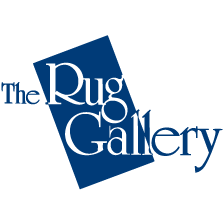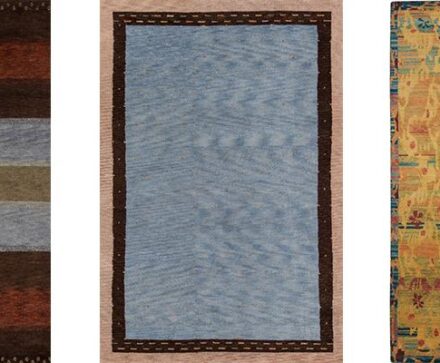What Is a Peshawar Rug?
Peshawar rugs are special not only for their beauty, but also for their backstory. If you are looking for a new rug, but aren’t sure what kind to get, this may be the type to consider. Listen to learn about their unique backstory, how they are made, and where to buy them.
John Maher: Welcome to The Rug Gallery with Sam Presnell. The Rug Gallery is an Oriental rug company and carpet store in Cincinnati, Ohio. I’m John Maher and I’m here with the owner of The Rug Gallery, Sam Presnell. Hi, Sam.
Sam Presnell: Hi, John.
How Peshawar Rugs Got Their Name
John: Sam, today we’re talking about Peshawar rugs. What is a Peshawar rug?
Sam: It’s a very interesting name. I like that it has “war” at the end of the name because that’s what’s going on there.
John: Really?

Sam: That has nothing to do with the name, I’m sure, but I just find it a coincidence because Peshawar is a border town to Afghanistan with the Pakistani border, Northwest Territory which everybody reads about, the very volatile, Taliban, terrorist type area. It’s what I would call the wild-wild west of Pakistan, at least. It’s like going back hundreds of years ago in the US when you went out west, everyone had guns. There was no law and order. That’s where everybody’s living in fear and it’s really tough.
Peshawar was basically a refugee town. Basically, how it developed from mostly Afghans. When the Taliban took over in Afghanistan, a lot of the North, especially in Northern Afghanistan, not so much of the Southern’, they left went the Taliban came in with their role. Their role was just not right for them. They settled in this camp, whatever you want to call it or city in Northwest Pakistan called Peshawar.
Basically, that’s what it is. What did they have to do? They couldn’t make any money. They’re third-world guests, in a third world country and they’re basically treated badly. They started to look at a way to feed themselves and make money and they started weaving what they knew. It was weave rugs. That’s what started. We did a lot of influence, it reminds me of a story that we talked about with the Tibetan people as well fleeing China, fleeing Tibetan settling to Nepal.
A very similar story, a lot of agencies got involved and how we could help them out. The US agencies, the whole world, NATO, everybody involved. The European countries got involved there as well and Scandinavia and tried to figure out how we could help them out. It was a very serious crisis that was happening there. Basically, the rug thing took off. One thing nice is that they were making their traditional weaves but making them more what we call transitional more modern type of Persian weaves or Afghan designs with our colorations and our sizes. It just took off and they were just incredible rugs and still are one of the best-selling rugs as far as hand-woven rugs go.
How Peshawar Rugs are Made
John: How are they made? Are they made any different than what we would think of as being an Oriental or Middle-Eastern type of rug?
Sam: Well, I would say not always. Like everything in this business, there are exceptions to everything. I would say the majority of it is, usually, one, it’s handspun wool. Even sometimes hand-carded, which is a very big influence on how that rug dyes up and looks after it’s dyed. Three is that they’re changing. Most of them are weaving in what we call a Turkish knot or a Ghiordes knot, which is very typical, a more tribal type of weaving that you would see in the Middle East. That gives a different appearance. They shear it extremely low which gives it a very worn-aged look to it. That’s the main things that you see different in a Peshawar rug.
How to Buy Peshawar Rugs
John: How can you buy a Peshawar rug if you’re interested in that? Are they just sold at any type of rug store?

Sam: Well, I think you can buy them at every rug store there is. I saw them at the company Ten Thousand Villages, here in Cincinnati, where they’re trying to support local weaver’s, things like that. Any specialty rug player would do it. Some department stores, if they have a very high-quality rug department would have it. I see them online all the time but I would say, like everything online, you can’t always believe what you see or read. Some of those are definitely not the same type of Peshawar rugs that we buy. Let’s put that way.
John: How would you tell the difference or know that you’re getting a really good quality or authentic Peshawar rug?
Sam: Well, it’s one of those old rules again. You’re really hard to judge quality online. If you’re doing that you’re really up to the individual site and how much integrity they have. A lot of times that’s a lot of claims are being made that they are not real. It’s really it’s hard to tell unless you give them side by side, you may not notice a difference. Somebody who doesn’t do it for a living wouldn’t know a difference.
To me, I look at, immediately I can see by the knot count. I can see by how it’s well woven. Usually a Persian weave, instead of a Turkish weave, the wools being used the dyestuffs being used. A lot of times it’s veg-dyed in Peshawar which is a really cool interpretation of design, things like that. Like everything, everybody’s always — once something becomes popular, there’s a lot of knockoffs and similar looks. There’s a lot of machine-made rugs that look like Peshawar rugs. They’ve done an awesome job. I mean, I have to give them credit. I’m very impressed with some of the reproductions that I’m seeing out there of even Peshawar rugs.
John: Interesting. All right. Thanks a lot for speaking with me today about Peshawar rugs, Sam.
Sam: All right, John. My pleasure, thank you.
John: For more information about Sam, The Rug Gallery and Oriental rugs and carpets visit ruggallerycincy.com. That’s rug gallery C-I-N-C-Y.com or call 513-793-9505. Make sure you catch the latest episodes by subscribing to this podcast on iTunes. If you could take the time to give us a review on iTunes, as well, we’d appreciate that. I’m John Maher. See you next time on The Rug Gallery.

